This morning there was a moderate sized earthquake below the megathrust in Chile. Here is the USGS website for this M 6.4 earthquake. Based upon the hypocentral depth, this appears to be along the megathrust fault (an “interface” event). However, the moment tensor shows extension (so this earthquake may be in the downgoing slab). Given the depth of this earthquake (deeper than the seismogenic zone, the region of the fault that can experience earthquakes, for most subduction zones), this is probably in the downgoing Nazca plate. This is a very seismically active region of the world, with a number of Great (M ≥ 8.0) earthquakes in recent years.
Below is my interpretive poster. I have plotted the epicenters (using the USGS earthquake feed kml) for the past 30 days with magnitudes 2.5 or greater, with color representing depth. I also include the slab depth contours from Hayes et al. (2012). These are the depth contours for the fault interface of the subduction zone. Today’s hypocentral depth is 90.8 km and the Hayes et al. (2012) slab contour in this region is between 80 and 100 km. I include the USGS moment tensor for this earthquake. I also plot the rupture length regions of historic earthquakes for this subduction zone in green (Beck et al., 1998 ). I present the patches for the 2010 and 2015 subduction zone earthquakes outlined in white dashed lines. Today’s earthquake happened in the region of the subduction zone that is “down-sip” from the 2010 earthquake. The 2010 earthquake would probably have loaded the fault in this region, so this M 6.4 earthquake may be related to the 2010 earthquake. However, it has been over 5 years since the 2010 earthquake. That being said, there are still aftershocks from the 2011 Tohoku-Oki earthquake (so it seems possible).
I also include the shaking intensity contours on the map. These use the Modified Mercalli Intensity Scale (MMI; see the legend on the map). This is based upon a computer model estimate of ground motions, different from the “Did You Feel It?” estimate of ground motions that is actually based on real observations. The MMI is a qualitative measure of shaking intensity. More on the MMI scale can be found here and here. This is based upon a computer model estimate of ground motions, different from the “Did You Feel It?” estimate of ground motions that is actually based on real observations.
I placed a moment tensor / focal mechanism legend on the poster. There is more material from the USGS web sites about moment tensors and focal mechanisms (the beach ball symbols). Both moment tensors and focal mechanisms are solutions to seismologic data that reveal two possible interpretations for fault orientation and sense of motion. One must use other information, like the regional tectonics, to interpret which of the two possibilities is more likely. Based on the moment tensor and my knowledge of the tectonics of this region, I interpret this earthquake to have had a right lateral strike slip motion along an east-west fault.
- In the upper left corner I place a cross section from Melnick et al. (2006). This shows the prehistoric earthquake history on the left and a cross section of the subduction zone on the right. This cross section is in the region of the 2010 subduction zone earthquake.
- In the upper right corner I include the space-time diagram from Beck et al. (1998 ) showing the along strike length of prehistoric earthquakes in the central subduction zone. The map above shows these prehistoric rupture strike lengths as green lines (labeled with green labels). The 2015 earthquake series ruptured past the southern boundary of the 1943 earthquake and about 30% into the 1922 earthquake region. There is a small gap between the 2010 and 2015 earthquake series, which aligns with the Juan Fernandez Ridge (a fracture zone in the Nazca plate; von Huene et al., 1997; Rodrigo et al., 2014). This fracture zone appears to be a structural boundary to earthquake slip patches (subduction zone segmentation), at least for some earthquakes. Beck et al. (1998 ) show that possibly two earthquakes ruptured past this boundary (1730 A.D. and possibly 1647 A.D., though that is queried). This segment boundary appears to be rather persistent for the past ~500 years
- In the lower right corner, I include a time-space diagram from Moernaut et al. (2010). This diagram extends further south than the Beck et al. (1998) figure.
- In the lower left corner I include an inset map from the USGS Seismicity History poster for this region (Rhea et al., 2010). There are two seismicity cross sections here as well, with their locations plotted on the map. The USGS plot these hypocenters along these two cross sections and I include those.
I include some inset figures in the poster.
- In February of this year, there was a M 6.3 earthquake near the coast which caused considerable damage. Below is my interpretive poster for that earthquake and here is my report.
- In September through November of 2015, there was a M 8.3 earthquake further to the north. Below is my interpretive poster for that earthquake and here is my report, where I discuss the relations between the 2010, 2015, and other historic earthquakes in this region. Here is my report from September.
- Here is a space time diagram from Beck et al. (1998 ). The 2015 earthquake occurs in the region of the 1943 and 1880 earthquakes. I updated this figure to show the latitudinal extent of the 2010 and 2015 earthquakes.
- Here is the space-time diagram from Moernaut et al., 2010. I include their figure caption below in blockquote.
Fig.: Setting and historical earthquakes in South-Central Chile. Data derived from Barrientos (2007); Campos et al. (2002); Melnick et al.(2009)
- The September 2015 earthquake series inspired me to compile some information on the historic tsunami in this region. Here is my report on those tsunami. Below I present my figure and an animation that compares these three tsunami from 1960, 2010, and 2014.
- These three maps use the same color scale. There is not yet a map with this scale for the 2015 tsunami, so we cannot yet make the comparison.
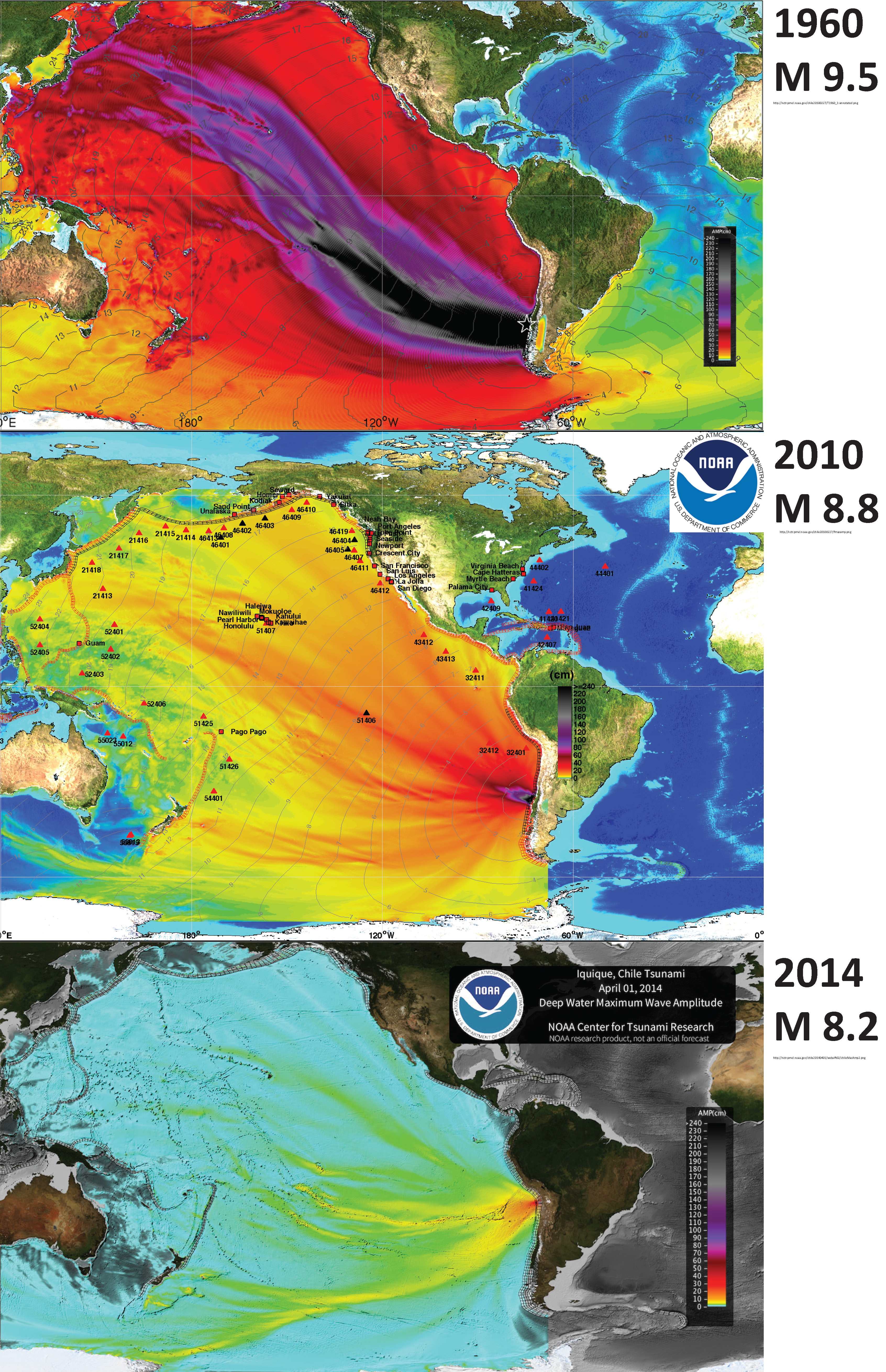
Here is an animation of these three tsunami from the US NWS Pacific Tsunami Warning Center (PTWC). This is the YouTube link.
- Here is the cross section of the subduction zone just to the south of this Sept/Nov 2015 swarm (Melnick et al., 2006). Below I include the text from the Melnick et al. (2006) figure caption as block text.
(A) Seismotectonic segments, rupture zones of historical subduction earthquakes, and main tectonic features of the south-central Andean convergent margin. Earthquakes were compiled from Lomnitz (1970, 2004), Kelleher (1972), Comte et al. (1986), Cifuentes (1989), Beck et al. (1998 ), and Campos et al. (2002). Nazca plate and trench are from Bangs and Cande (1997) and Tebbens and Cande (1997). Maximum extension of glaciers is from Rabassa and Clapperton (1990). F.Z.—fracture zone. (B) Regional morphotectonic units, Quaternary faults, and location of the study area. Trench and slope have been interpreted from multibeam bathymetry and seismic-reflection profiles (Reichert et al., 2002). (C) Profile of the offshore Chile margin at ~37°S, indicated by thick stippled line on the map and based on seismic-reflection profiles SO161-24 and ENAP-017. Integrated Seismological experiment in the Southern Andes (ISSA) local network seismicity (Bohm et al., 2002) is shown by dots; focal mechanism is from Bruhn (2003). Updip limit of seismogenic coupling zone from heat-fl ow measurements (Grevemeyer et al., 2003). Basal accretion of trench sediments from sandbox models (Lohrmann, 2002; Glodny et al., 2005). Convergence parameters from Somoza (1998 ).
- In March 2015, there was some seismicity in this September/November 2015 earthquake slip region. I put together an earthquake report about those earthquake of magnitudes M = 5.0-5.3. I speculate that the 1922 earthquake region is a seismic gap. Note that this September/November 2015 earthquake region is along the southern portion of the seismic gap that I labeled on the map below. Dutchsinse can kiss my 4$$.
- Here is a map that shows the recent swarm of ~M = 5 earthquakes. There are moment tensors for the earthquakes listed below, some recent historic subduction zone earthquakes. I placed the general along-strike distance for older historic earthquakes in green (and labeled their years). The largest earthquake ever recorded, the Mw = 9.5 Chile earthquake, had a slip patch that extends from the south of the map to just south of the 2010 earthquake swarm. The 2010 and 2014 earthquake swarm epicenters are plotted as colored circles, while most other historic earthquake epicenters are plotted as gray circles. Note how this March 2015 swarm is at the northern end of the 1922/11/11 M 8.3 earthquake. At the bottom of this page, I put a USGS graphic about what these moment tensor plots (beach balls) tell us about the earthquakes.
- Hundreds of people died as a result of the 1922 earthquake. The USGS has more news reports about the 1922 earthquake here. There were also reports of a tsunami over 9 meters. So we know that this segment of the fault can produce large earthquakes and tsunami. However, it has been about a century since the last Great subduction zone earthquake in this region of the fault.
-
Here are the main earthquakes in the above map:
- 1922/11/7 M 7.0
- 1922/11/11 M 8.3
- 1995/07/30 M 8.0
- 1997/10/15 M 7.1
- 2007/11/14 M 7.7
- 2010/2/27 M 8.8
- 2014/4/1 M 8.2
-
There was significant subduction zone seismicity to the north of this region in 2014. I put together some material for the 2014 earthquake in the past. The page where I summarize some of my reports on the 2014 earthquake are found here.
- Interseismic Fault Coupling: the 2014 March Northern Chile Swarm 3/27/14: There were some earthquakes in this region of the subduction zone, so I started posting information about historic earthquakes there.
- M 8.2 earthquake in northern Chile 4/1/14: Here is the main page. There are a couple excellent animations from IRIS on this page!!!
- Tsunamis in the region of the M 8.2 northern Chile earthquake 4/1/14
- M 8.2 northern Chile tsunamis recorded at tide gages 4/2/14
- large magnitude aftershock in northern Chile 4/2/14: the second patch that slipped
- all right, another M 6.2 aftershock in Chile 4/2/14: another large aftershock in the 2014 swarm
- northern Chile M 8.2 earthquake series animations 4/3/14: I put this together to show how this swarm slipped two distinct patches (sub-faults in modeling parlance, asperities in Aki parlance)
- M 6.7 earthquake swarm in northern Chile! 2014/03/06: This is the swarm that started it all.
References:
- Beck, S., Barientos, S., Kausel, E., and Reyes, M., 1998. Source Characteristics of Historic Earthquakes along the Central Chile Subduction Zone in Journal of South American Earth Sciences, v. 11, no. 2., p. 115-129.
- Hayes, G.P., Wald, D.J., and Johnson, R.L., 2012. Slab1.0: A three-dimensional model of global subduction zone geometries in, J. Geophys. Res., 117, B01302, doi:10.1029/2011JB008524
- Hayes, G.P., Smoczyk, G.M., Benz, H.M., Villaseñor, Antonio, and Furlong, K.P., 2015. Seismicity of the Earth 1900–2013, Seismotectonics of South America (Nazca Plate Region): U.S. Geological Survey Open-File Report 2015–1031–E, 1 sheet, scale 1:14,000,000, http://dx.doi.org/10.3133/ofr20151031E.
- Melnick, D., Bookhagen, B., Echtler, H.P., and Strecker, M.R., 2006. Coastal deformation and great subduction earthquakes, Isla Santa María, Chile (37°S) in GSA Bulletin, v. 118, no. 11/12, p. 1463-1480.
- Moernaut, J., Batist, M., Haeirman, K., Van Daele, M., Brümmer, R., Urrutia, R., Wolff, C., Brauer, A., Roberts, S., Kilian, R., Pino, M., 2010. Recurrence of 1960-like earthquake shaking in South-Central Chile revealed by lacustrine sedimentary records in proceedings Chapman Conference on Giant Earthquakes and Their Tsunamis Valparaíso, Viña del Mar, and Valdivia, Chile 16–24 May 2010.
- Rhea, Susan, Hayes, Gavin, Villaseñor, Antonio, Furlong, K.P., Tarr, A.C., and Benz, H.M., Seismicity of the earth 1900–2007, Nazca Plate and South America: U.S. Geological Survey Open-File Report 2010–1083-E, 1 sheet, scale 1:12,000,000.
- Rodrigo, C. and Lara, L.E., 2014. Plate tectonics and the origin of the Juan Fernández Ridge: analysis of bathymetry and magnetic patterns in Lat. Am. J. Aquat. Res, v. 42, no. 4, p. 907-917
- von Huene, R. et al., 1997. Tectonic control of the subducting Juan Fernandez Ridge on the Andean margin near Valparaiso, Chile in Tectonics, v. 16, no. 3, p. 474-488.
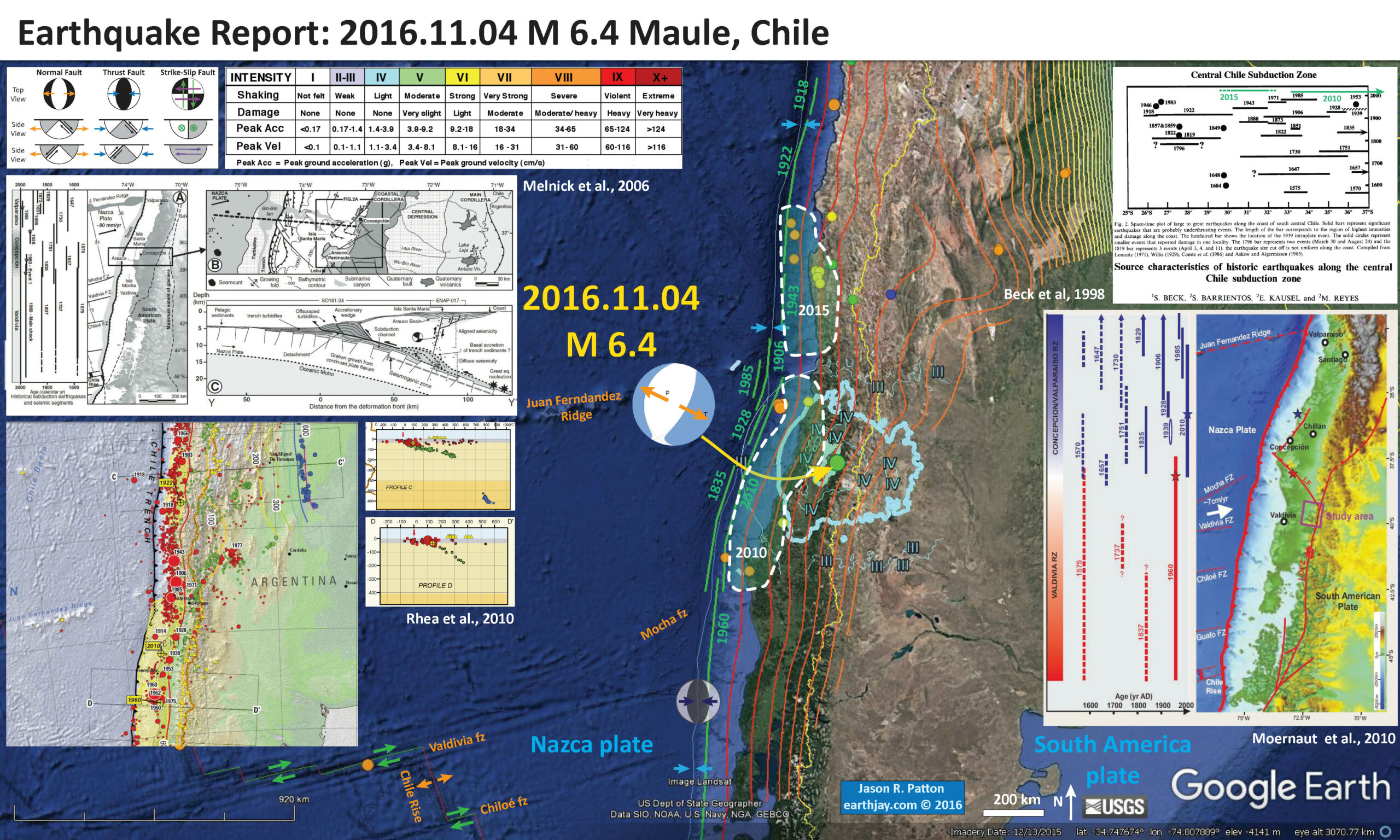
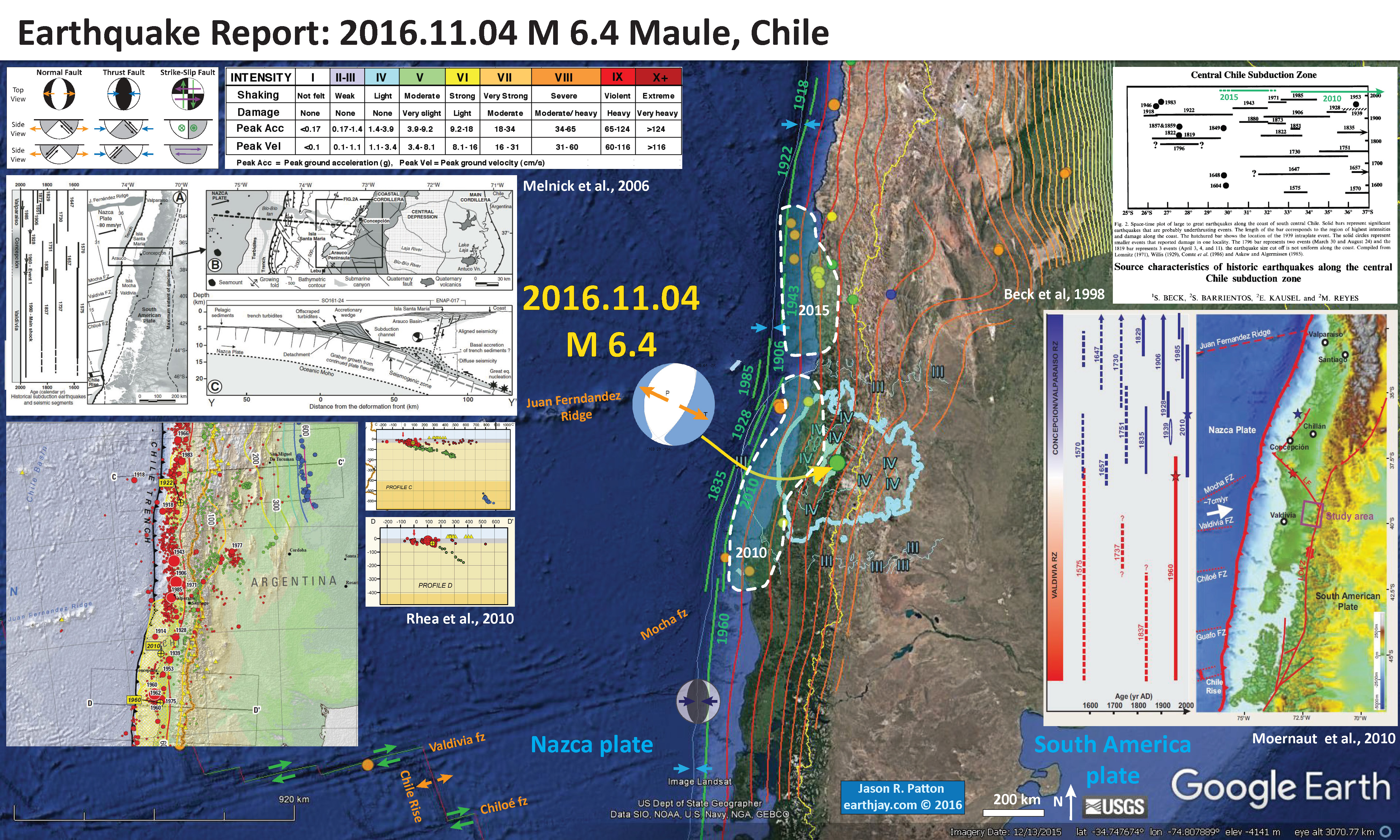
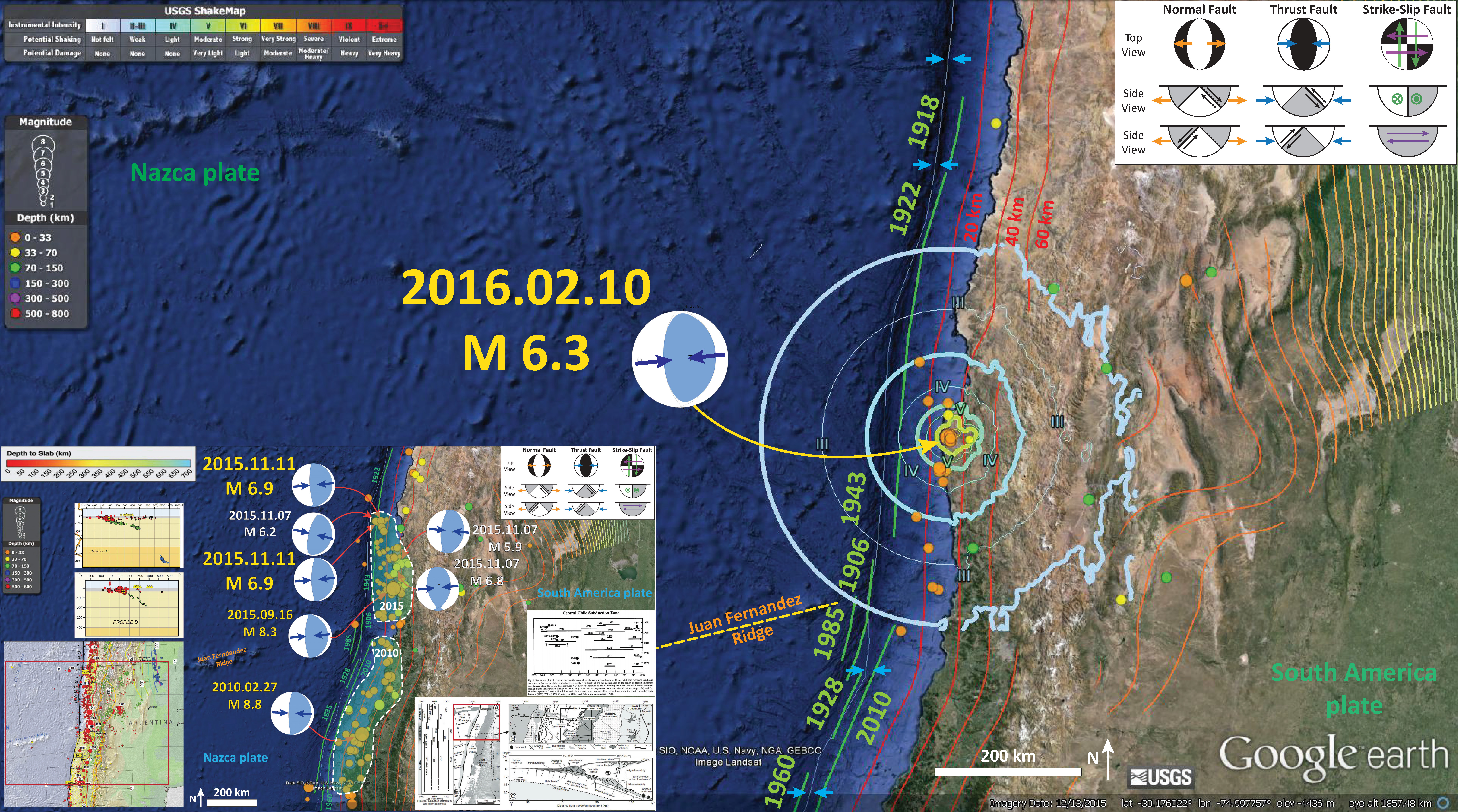
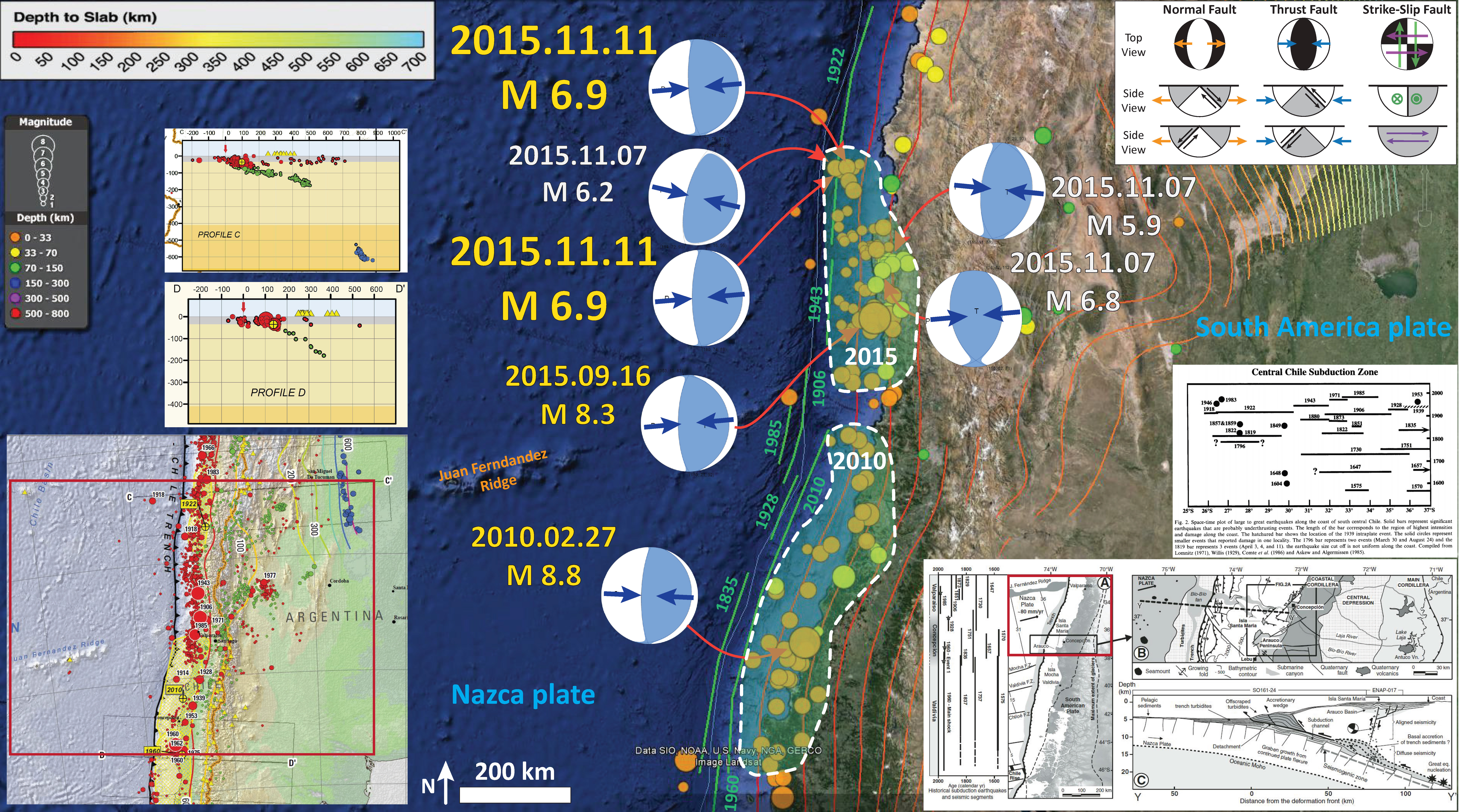

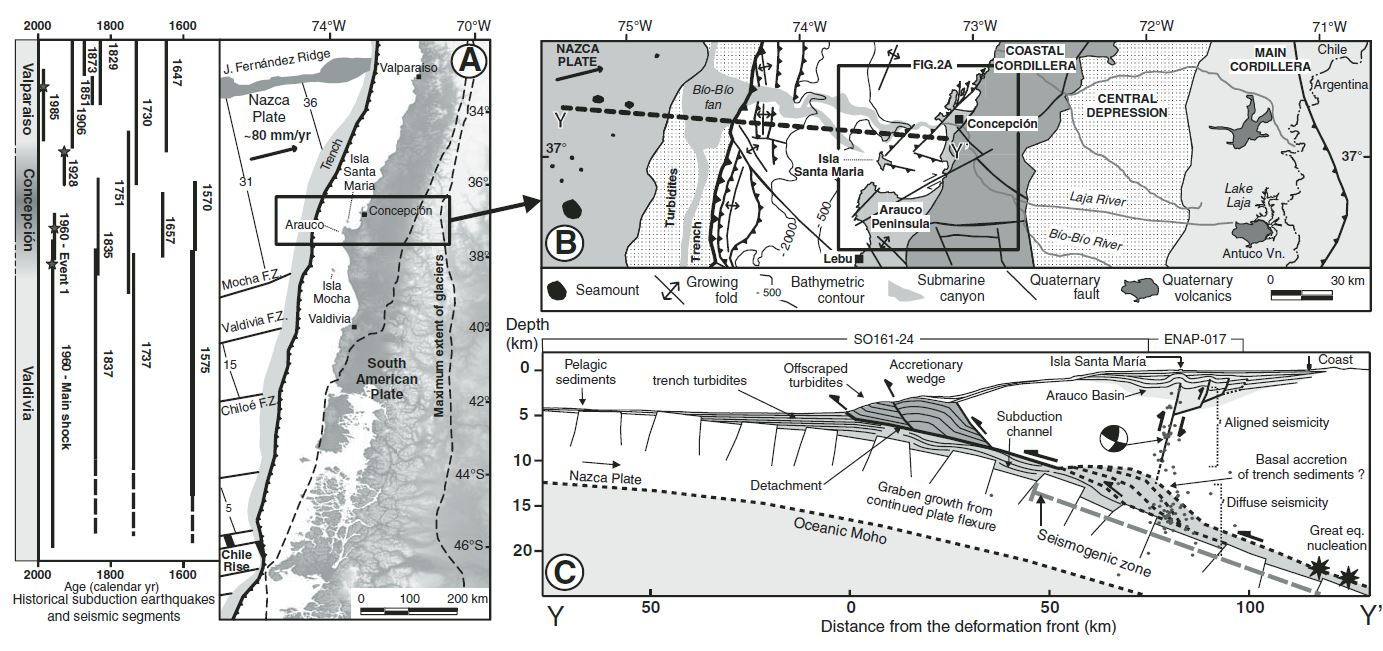
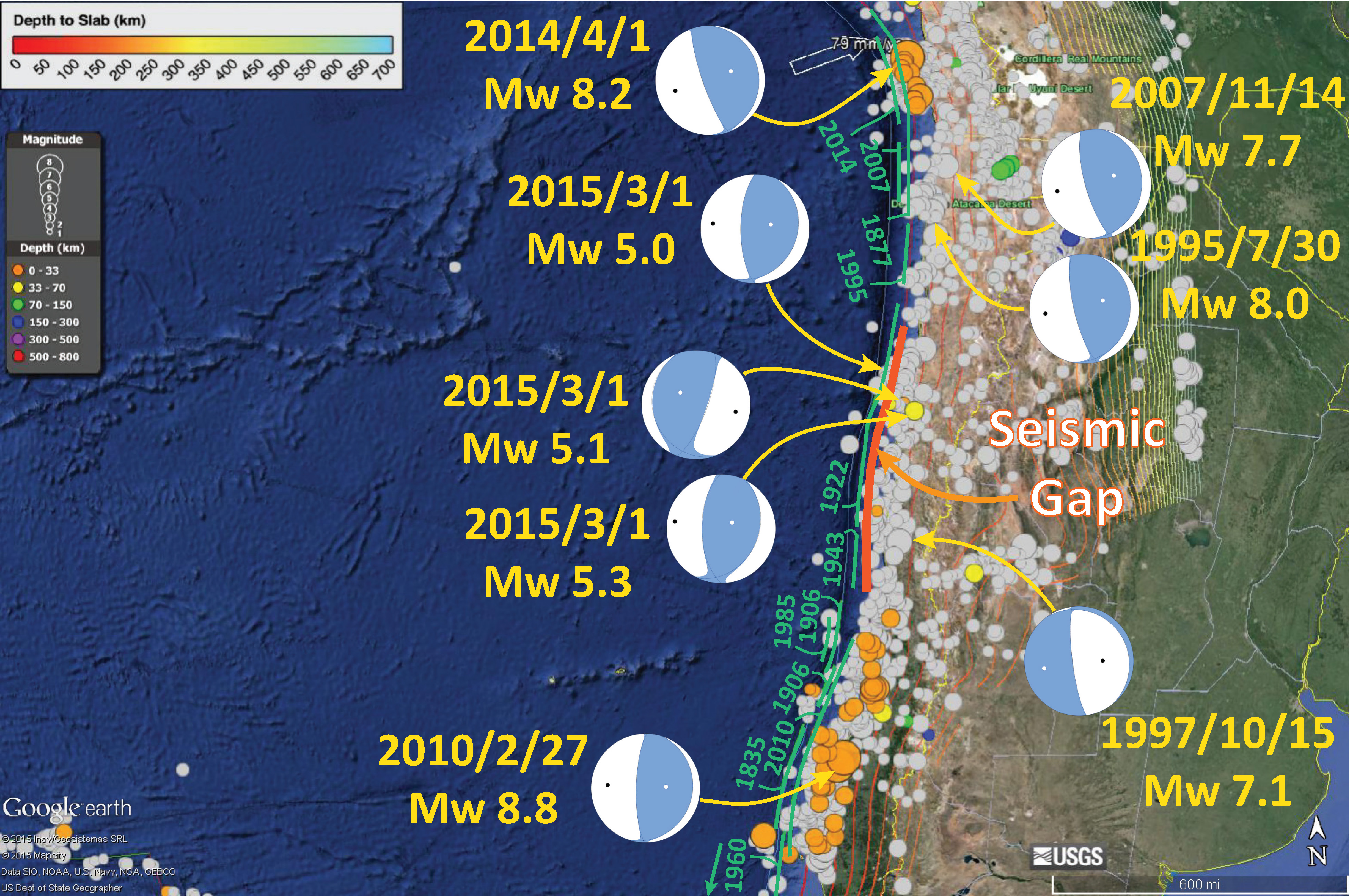
2 thoughts on “Earthquake Report: Maule, Chile!”